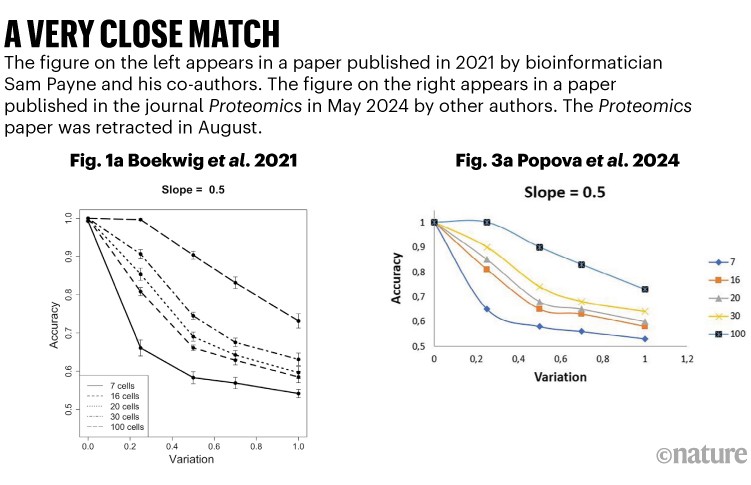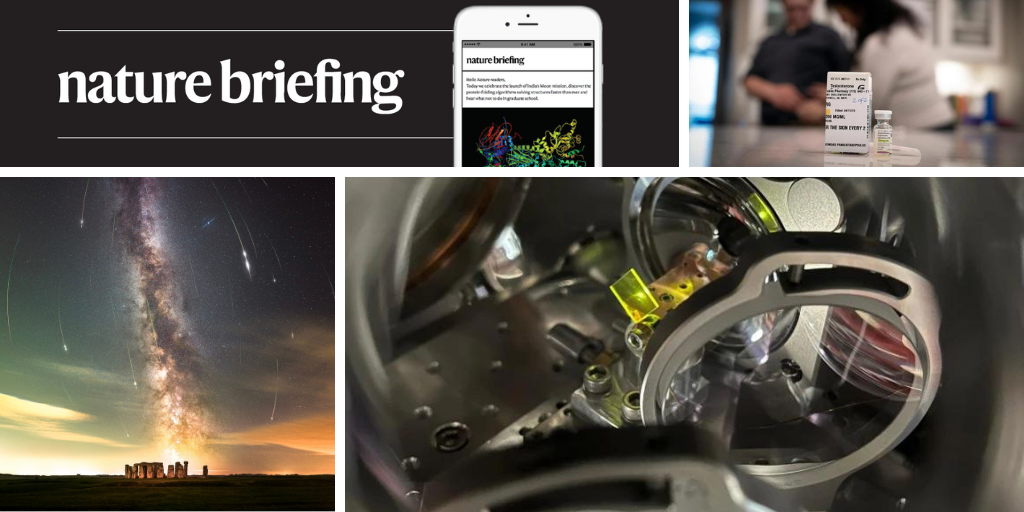Hello Nature readers, would you like to get this Briefing in your inbox free every day? Sign up here.

Credit: Josh Dury
To capture the spectacle of the Perseid meteor shower, seen each year when Earth passes through debris left by the comet Swift–Tuttle, astrophotographer Josh Dury combined 43 images of the meteors, Stonehenge and the Milky Way taken over three and half hours.
See more of the month’s sharpest science shots, selected by Nature’s photo team.
Physicists have demonstrated all the ingredients of a nuclear clock — a device that keeps time by measuring tiny energy shifts inside an atomic nucleus. The breakthrough came from probing the nuclei of a rare isotope with a laser device called a frequency comb. Although the set-up isn’t technically a clock, because it hasn’t been used to measure time, “such impressive results make the development of a nuclear clock seem possible”, says atomic physicist Marianna Safronova. “It’s really one of the most exciting papers in recent times.”
When trans men receive testosterone therapy, their immune systems begin to resemble those of cis men. Researchers collected blood samples from trans men before they began gender-affirming hormone therapy, three months into treatment and a year into treatment. As treatment progressed, the men’s immune response shifted from one characterized by virus-fighting proteins to one featuring proteins associated with muscle growth. The results suggest that sex hormones play a part in regulating immune pathways, echoing real-world trends in disease susceptibility for men and women. As testosterone levels go up and oestrogen levels go down, it seems as if the immune system passes through a balance point, says immunologist and co-author Petter Brodin.
Although depression comes and goes, people who are prone to it retain a distinct pattern of brain-wiring network throughout their lives. An analysis of more than 180 functional magnetic resonance images showed that compared with healthy controls, people with clinical depression have larger brain circuits called salience networks, which shape what the brain pays attention to. These networks become more active during a depressive episode but persist even after the depression lifts. Researchers found large salience networks in children as young as nine years old, who then went on to develop depression as teenagers. This suggests that the trait could increase the risk of depression, rather than being a result of it.
Features & opinion
South Korea has more researchers per capita, and spends proportionally more on science, than most countries. But its ‘bang for buck’ — judged by pitting research spend against output — is surprisingly low, notes an editorial in Nature Index. Observers say that the country seems to be at an inflection point, where it either pivots and adapts, or struggles to keep pace. Many researchers would like to see the country engage in more diverse partnerships — acceptance into the European Union’s Horizon Europe funding programme is a positive step, they say. And South Korea could do more to benefit from the talents of its female scientists: just 23% of its researchers are women.
This editorially independent article is part of Nature Index 2024 South Korea.
When bioinformatician Sam Payne was asked to review a manuscript on a topic relevant to his research, what he was given was a little too close to home. The text, he says, was similar to that of a paper he’d authored three years earlier, with several data plots identical to those in his paper. Although the manuscript was rejected after Payne raised the alarm, he later found it published in another journal. Some of the authors of the now-retracted paper were found to have possible links to a paper mill. Studies sold by paper mills are plaguing scientific publishing despite countermeasures from some journals. “It was just a complete lucky break that the person asked to review it was the author,” says Lisa Rasmussen, editor-in-chief of the journal Accountability in Research. “Our system should not depend on that kind of serendipity.”

Source: Ref. 1 and Ref. 2
With 30 years of industry experience under his belt, Mark Klenk has seen the good, the bad and the ugly when recruiting for and interviewing candidates for tech jobs. Now, as a technology-industry interview coach, he shares his top tips to help prospective candidates avoid mistakes, stand out and secure an offer.
Do you have a work dilemma you’d like some help with? E-mail [email protected]


